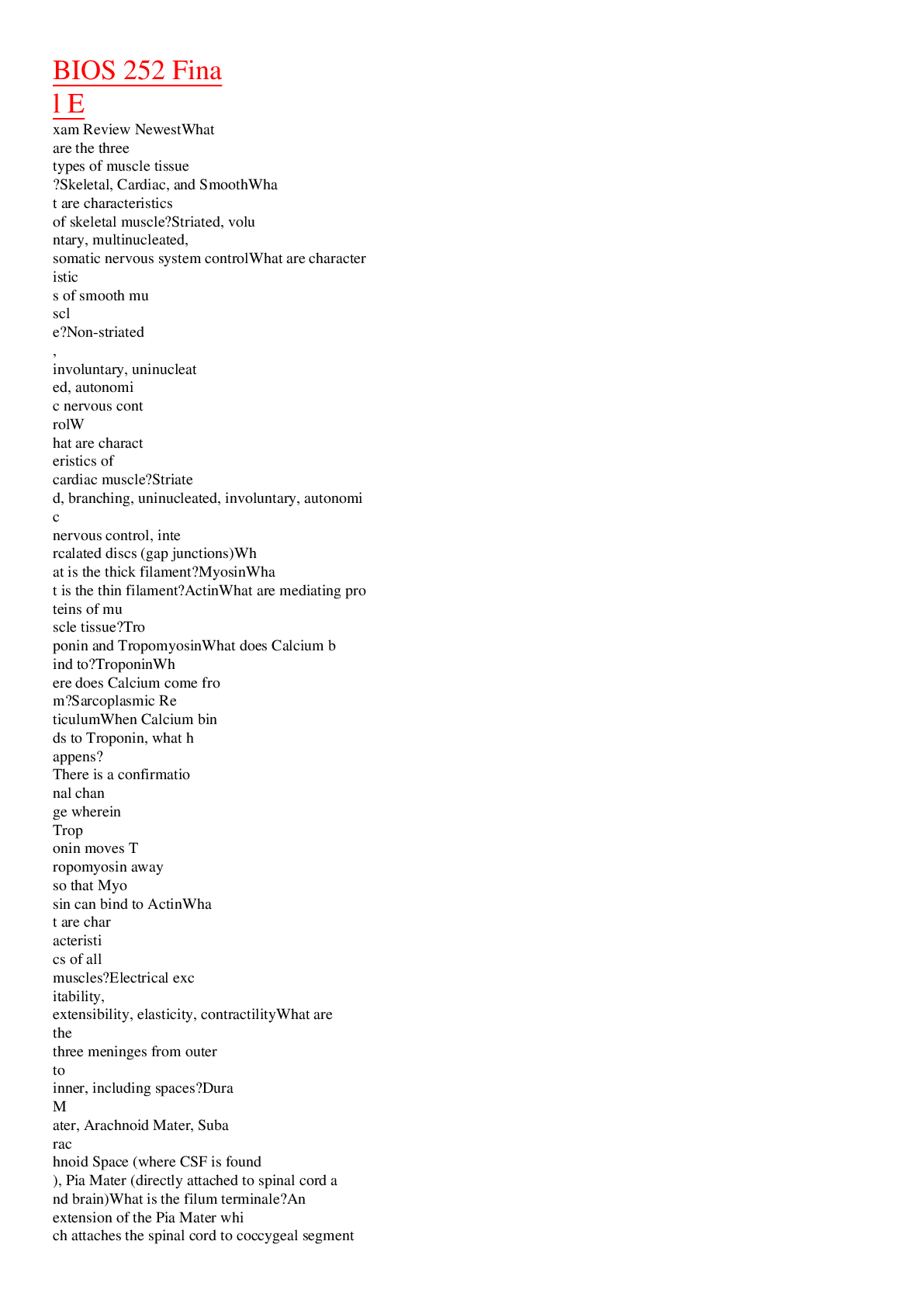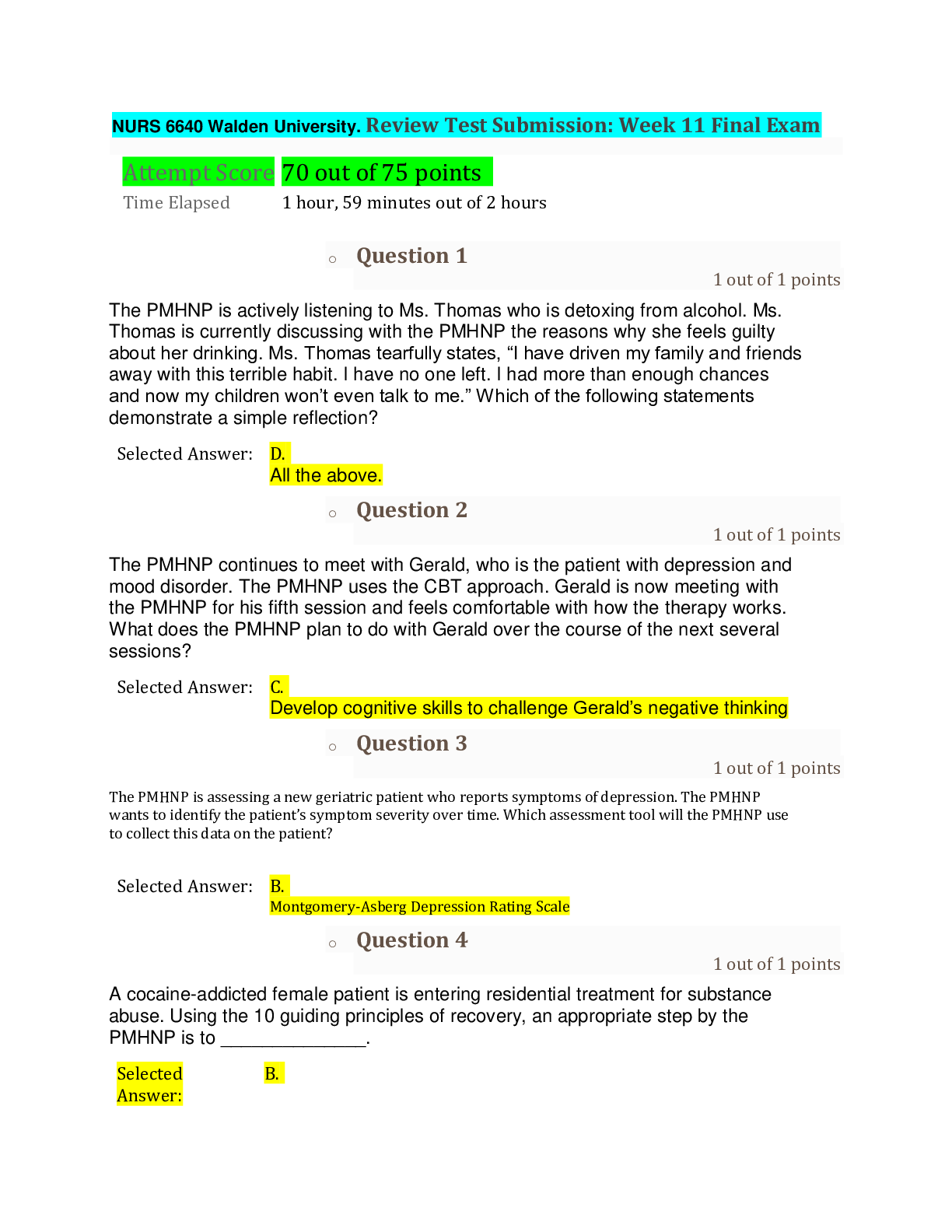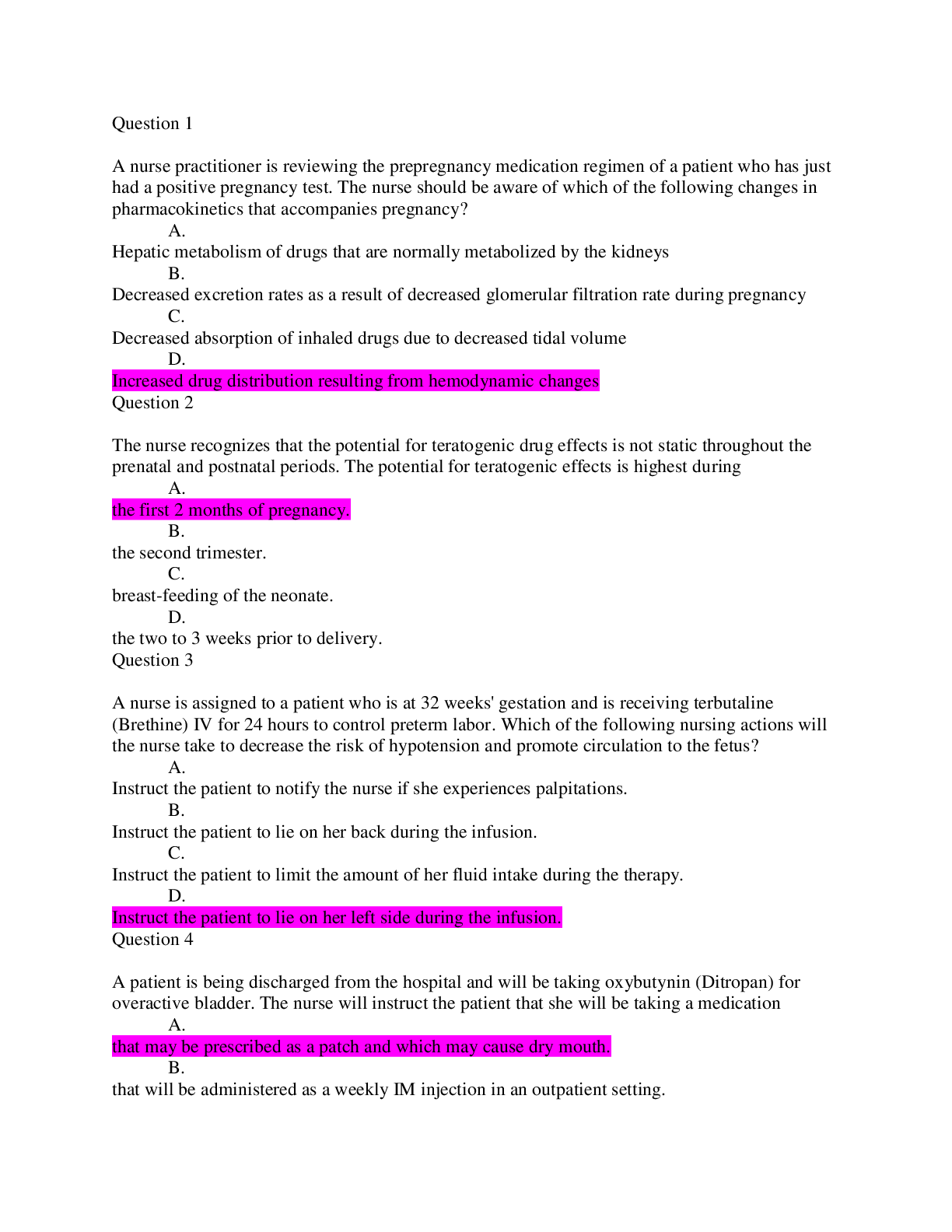BIOS 252 Final Exam Review Newest
Document Content and Description Below
BIOS 252 Final Exam Review Newest BIOS 252 Final Exam Review Newest What are the three types of muscle tissue? Skeletal, Cardiac, and Smooth What are characteristics of skeletal muscle? Striate... d, voluntary, multinucleated, somatic nervous system control What are characteristics of smooth muscle? Non-striated, involuntary, uninucleated, autonomic nervous control What are characteristics of cardiac muscle? Striated, branching, uninucleated, involuntary, autonomic nervous control, intercalated discs (gap junctions) What is the thick filament? Myosin What is the thin filament? Actin What are mediating proteins of muscle tissue? Troponin and Tropomyosin What does Calcium bind to? Troponin Where does Calcium come from? Sarcoplasmic Reticulum When Calcium binds to Troponin, what happens? There is a confirmational change wherein Troponin moves Tropomyosin away so that Myosin can bind to Actin What are characteristics of all muscles? Electrical excitability, extensibility, elasticity, contractility What are the three meninges from outer to inner, including spaces? Dura Mater, Arachnoid Mater, Subarachnoid Space (where CSF is found), Pia Mater (directly attached to spinal cord and brain) What is the filum terminale? An extension of the Pia Mater which attaches the spinal cord to coccygeal segment What is an isometric contraction? Length of muscle does not change, but tension does What is an isotonic contraction? Length of muscle changes, but tension does not What is a concentric isotonic contraction? Muscle shortens What is an eccentric isotonic contraction? Muscle lengthens What is an agonist? Prime mover What is an antagonist? Opposes action of the prime mover What is a synergist? An "assistant" or "helper" muscle to the agonist What is a fixator? Stabilizes muscles What is the origin? Point of origin for a muscle with NO movement What is the insertion Where the muscle inserts, non-stable end where most of the movement associated with the muscle is performed In a first class lever system, what is in the middle? Fulcrum In a second class lever system, what is in the middle? Load In a third class lever system, what is in the middle? Effort What are the neuroglial cells of the CNS and their functions? Astrocytes (blood brain barrier), Oligodendrocytes (myelinator--can myelinate MULTIPLE CNS neuron axons), Microglial (phagocyte/clean-up cells), Ependymal Cell (CSF production) What are the neuroglial cells of the PNS and their functions? Satellite cells (cover the surface of nerve cell bodies in sensory, sympathetic, and parasympathetic ganglia), Schwann cells (myelinator--only myelinates ONE PNS cell) Saltatory conduction happens in which type of neuron? Is this fast or slow conudction? Myelinated neurons, fast Continuous conduction happens in which type of neuron? Is this fast or slow conduction? Unmyelinated neurons, slow What are the special senses? Sight, hearing, taste, balance, smell What are the three divisions of the ear? External ear (auricle, external auditory meatus, tympanic membrane), Middle ear (incus, malleus, stapes, eustachian tube), Inner ear (cochlea, vestibule, semicircular canals) What is the flow of information in hearing? External ear to middle ear to inner ear, transcribed into electrical impulse by cochlea which contains hearing receptors in the organ of Corti in the scala media, carried by cranial nerve VIII to temporal lobe for interpretation Which structure is responsible for linear balance? Vestibule Which structure is responsible for dynamic balance? Semicircular canals Describe the sliding contraction theory Acetylcholine NT is released from synaptic end bulbs of neuron, crossing over synaptic cleft, binds to ligand gated receptor present on muscle tissue sarcolemma, generating a muscle end action potential traveling down the T-Tubule. This activates the sarcoplasmic reticulum to release calcium. From there, Ca binds to Troponin, moving Tropomyosin, allowing Myosin to bind to Actin with the help of ATP. Where does ATP come from in the muscle? Creatine Phosphate, Anaerobic Glycolysis, Cellular Respiration What are the structures of the eye? Cornea, Sclera, Lens, Iris, Macula Lutea, Optic Disc, Retina What are the photoreceptors of the eye? Rods (see black and white) and Cones (see color), only present in retinal layer What is the flow of information in the eye? Cornea, lens, optic nerve (CN II), optic chiasm, optic tract, thalamus (lateral geniculate nucleus), optic radiations, occipital cortex What structure refracts light? Lens, causing the information to be concentrated on the Macula Lutea. What is the "blind spot"? Optic disc What functions are associated with the various lobes of the brain? Occipital: vision, Temporal: hearing, Parietal: sensation/feeling, Frontal: motor skills/personality What is the precentral gyrus? Primary motor cortex What is the postcentral gyrus? Primary sensory cortex What is Broca's area? Located in frontal lobe of the dominant hemisphere of your brain, used for producing speech. This develops BEFORE Wernicke's area, which is why infants can babble but don't make sense. What is Wernicke's area? Found in temporal lobe, used for making sense of speech and comprehension (both of your own speech and of the speech of others) What parts of the gray matter tissue of the spinal cord are responsible for which functions? Anterior horn: somatic motor neurons, Posterior horn: all sensory information, Lateral horn: autonomic system both sympathetic (T1-L2/L3) and parasympathetic (brain stem, S2-S4) What are the cranial nerves and their functions? CNI: Sensory, Smell CN II: Sensory, Sight CN III: Motor, Moving eyes CN IV: Motor, Moving eyes CN V: Both, Facial feeling and chewing CN VI: Motor, Moving eyes CN VII: Both, Facial expression CN VIII: Sensory, Hearing and Balance CN IX: Both, Salivary gland innervation, swallowing, taste on posterior 1/3 of tongue CN X: Both, Speaking, tasting with epiglottis, cardiovascular depression, defecation/urination CN XI: Motor, Shoulder elevation and depression CN XII: Motor, Tongue movement What is the resting membrane potential? -70mV, cell is more negative due to proteins and Potassium (K) inside the cell What is depolarization? Sodium (Na) rushes into the cell, making it more positive What is repolarization? Potassium (K) leaves the cell What is hyperpolarization? Too much Potassium (K) leaves the cell What is an EPSP? Graded potential leads to membrane becoming LESS negative, leading to an action potential if cell membrane reaches -55mV What is an IPSP? Graded potential leading to membrane become MORE negative (hyperpolarized), inhibiting an action potential What are the components of a reflex arc in order? Sensory receptor, sensory neuron, integration center, motor neuron, effector organ (often muscle) What are the ascending (sensory tracts) we must know? Spinothalamic, Posterior Column Medial Lemniscus, Spinocerebellar, Trigeminothalamic What are the descending (motor tracts) we must know? Corticobulbar, Corticospinal, Rubrospinal, Tectospinal (if it isn't sensory, assume it's motor!) What is the CNS? Brain and Spinal Cord What is the PNS? Everything else: spinal nerves, cranial nerves, peripheral nerves, etc. What three types of cells are involved in sense of smell? Basal stem cells, olfactory receptors, support cells Where do you find olfactory receptors? Epithelium of nasal cavity Short term memory is stored where? Hippocampus What are the components of the brain stem and their functions? Midbrain: Relaying of visual/auditory information, Pons: Respiration, Medulla Oblongata: Heart function, Digestion, Defecation/Urination What are the components of the Diencephalon and their functions? Hypothalamus (Homeostasis, controlling of parasympathetic functions, controlling of endocrine system), Thalamus (GPS), Epithalamus (production of Melatonin in Pineal gland) Prosencephalon becomes what? Cerebrum What is the flow of information through a neuron? Dendrites to cell body to axon hillock to axon to axon terminals What are some important neurotransmitters? Acetylcholine, Dopamine, Epinephrine, Norepinephrine A selective destruction of substantia nigra pars compacta in midbrain leading to a lack of production of Dopamine leads to what disease process? What is seen in this disease? Parkinson's Disease, resting tremor, resistance in movement What are the three types of memory? Immediate, Short, and Long term How many hemispheres of the brain are there and how are they connected? Two; connected by commisural tracts of corpus callosum What are the 6 extraoccular muscles of the eye? Superior Rectus, Inferior Rectus, Lateral Rectus, Medial Rectus, Superior Oblique, Inferior Oblique What is the function of the Deltoid? Abduction of shoulder What is the function of Biceps Brachii? Flexion of elbow and shoulder What is the function of Triceps Brachii? Extension of elbow What is the function of Latissimus Dorsi? Adduction of the arm, medial rotation of the shoulder What is the function of Teres Major? Adduction and medial rotation of humerus What is the function of Teres Minor External rotation of the shoulder What are the locations of the cranial nerves? What is the flow of CSF? Produced in lateral ventricles by choroid plexus, moves through interventricular foramen to third ventricle, moves through cerebral aqueduct to fourth ventricle, lateral aperture to end up in subarachnoid space of brain, or medial aperture to end up in subarachnoid space of spinal cord What are the structures of the eye? What are the structures of the brain? How do exocrine glands function? Excrete their substances through ducts How do endocrine glands function? Excrete their substance directly into bloodstream or free surface What are some exocrine glands? sudoriferous (sweat), sebaceous (oil), mucous, digestive, salivary, parotid, and several others throughout the body What are some endocrine glands? pituitary, thyroid, parathyroid, thymus, adrenal, ovaries/testes/pancreas (these can be both endo and exo), and pineal glands What are paracrines? Local hormones that do not circulate What are autocrines? Hormones that act on the cell that released them What are endocrine hormones? Can be used by any part of the body What are characteristics of water-soluble hormones? Cannot penetrate through cell membrane unless a special channel is present. Most are larger in size. They rely on second messenger proteins to affect the inside of a cell. What are characteristics of lipid-soluble hormones? circulate bound to transport proteins Can directly pass through cell membrane and cause transcription DNA changes directly in the nucleus What are some lipid soluble hormones? Thyroid hormones, Steroids, Nitric Oxide What are some water soluble hormones? Amine hormones, Peptide and Protein Hormones, Eicosanoid Hormones What system connects hypothalamus with pituitary? hypophyseal portal system What does anterior pituitary secrete? Human Growth Hormone (HGH): Makes person grow and develop Thyroid-stimulating Hormone (TSH): Acts on thyroid to stimulate thyroid hormones Follicle-stimulating Hormone (FSH): Stimulates gonads Luteinizing Hormone (LH): Stimulates gonads Prolactin (PRL): Stimulates milk production Adrenocorticotropic Hormone (ACTH): Works on adrenal cortex and causes person to start making specific hormones Melanocyte-stimulating Hormone (MSH): Stimulate melanocyte production What does hypothalamus secrete? Oxytocin (OT): Involved in labor and delivery, movement of milk, emotional connection Anti-diuretic Hormone (ADH): Involved in water retention from urine What does the parathyroid secrete and what does it do? Parathyroid Hormone PTH, Breaks down bone to increase serum blood calcium levels What are the two MAIN parts of the adrenal glands? Cortex and Medulla What are the three parts of the outer cortex of the adrenal glands? The zona glomerulosa: Secretes hormones called mineralocorticoids used to regulate mineral homeostasis, which is a salt hormone, makes aldosterone, puts person at risk for hypertension The zona fasciculata: Secretes hormones called glucocorticoids that affect glucose homeostasis, the "sugar" layer The zona reticularis: Secretes weak androgens (sex hormones) Remember: Salt, Sugar, Sex Is the pancreas endocrine or exocrine? Both What is the exocrine portion of the pancreas and what does it produce? Acini: produce digestive enzymes that are delivered to the GI tract through ducts What is the endocrine portion of the pancreas and what does it produce? The islets of Langerhans: include 4 types of cells that secrete different ENDOCRINE hormones Alpha (A) cells--glucagon Beta (B) cells--insulin These are DIRECTLY INVOLVED IN BLOOD SUGAR REGULATION What do the ovaries produce? Ovaries produce two estrogens (estradiol and estrone), progesterone, relaxin, and inhibin What do the testes produce? Testes produce testosterone Where is the pineal gland and what does it produce? The pineal gland is attached to the roof of the third ventricle of the brain and secretes melatonin Where is the thymus and what does it produce? The thymus is located behind the sternum between the lungs and produces thymosin, thymic humoral factor (THF), thymic factor (TF), and thymopoietin What is pituitary gigantism? Pituitary gigantism and acromegaly are caused by excess secretion of growth hormone (excess growth and size) What is a goiter? Goiter is caused by an abnormality in the production of thyroid hormone (tumorous appearance of thyroid) What is Graves Disease? Graves disease (with associated exophthalmos) develops due to excess thyroid hormone (eyes bulging out) [Show More]
Last updated: 2 years ago
Preview 1 out of 9 pages

Buy this document to get the full access instantly
Instant Download Access after purchase
Buy NowInstant download
We Accept:

Reviews( 0 )
$12.00
Can't find what you want? Try our AI powered Search
Document information
Connected school, study & course
About the document
Uploaded On
Nov 07, 2022
Number of pages
9
Written in
Additional information
This document has been written for:
Uploaded
Nov 07, 2022
Downloads
0
Views
73


























